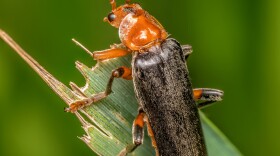When most people think of butterflies, feelings and images of tranquility and beauty often float to mind.
Sure, males of the same butterfly species may engage in energetic aerial competition when seeking a mate, but there is certainly truth to the statement, “As peaceful as a butterfly.”
The idea of a butterfly innocently munching on leaves during its youthful days as a caterpillar and then fluttering from flower to flower to sip nectar as an adult only adds to this impression.
However, as we’ve said before, when it comes to nature (and especially the insect world), there are always exceptions. With that in mind, you may still be surprised to learn that not every butterfly lives its life as a peaceful vegetarian.
Introducing, the Harvester Butterfly …the only species of butterfly in North America where the caterpillars eat meat. More specifically, Woolly aphids are on their limited menu.
Found in the eastern and central United States, Harvester’s prefer wet woodland and riparian habitat …the type of habitat where Alders grow and where their preferred meal, the Woolly Alder Aphid thrives.
When getting ready to lay eggs, a female Harvester will look for a plant that’s loaded with aphids, laying her eggs among the crowd. Once the caterpillars emerge, the aphid feast begins.
Interestingly enough, it’s not just in the caterpillar stage that aphids provide food for these unique butterflies. However, in the case of the adult Harvesters, they’re not after flesh. Instead they use their straw-like proboscis to drink honeydew, a sugary secretion produced by the aphids.
Passing up flowers, the adult butterflies will also sample tree sap and mineral rich fluids from dung and mud. Yum!





